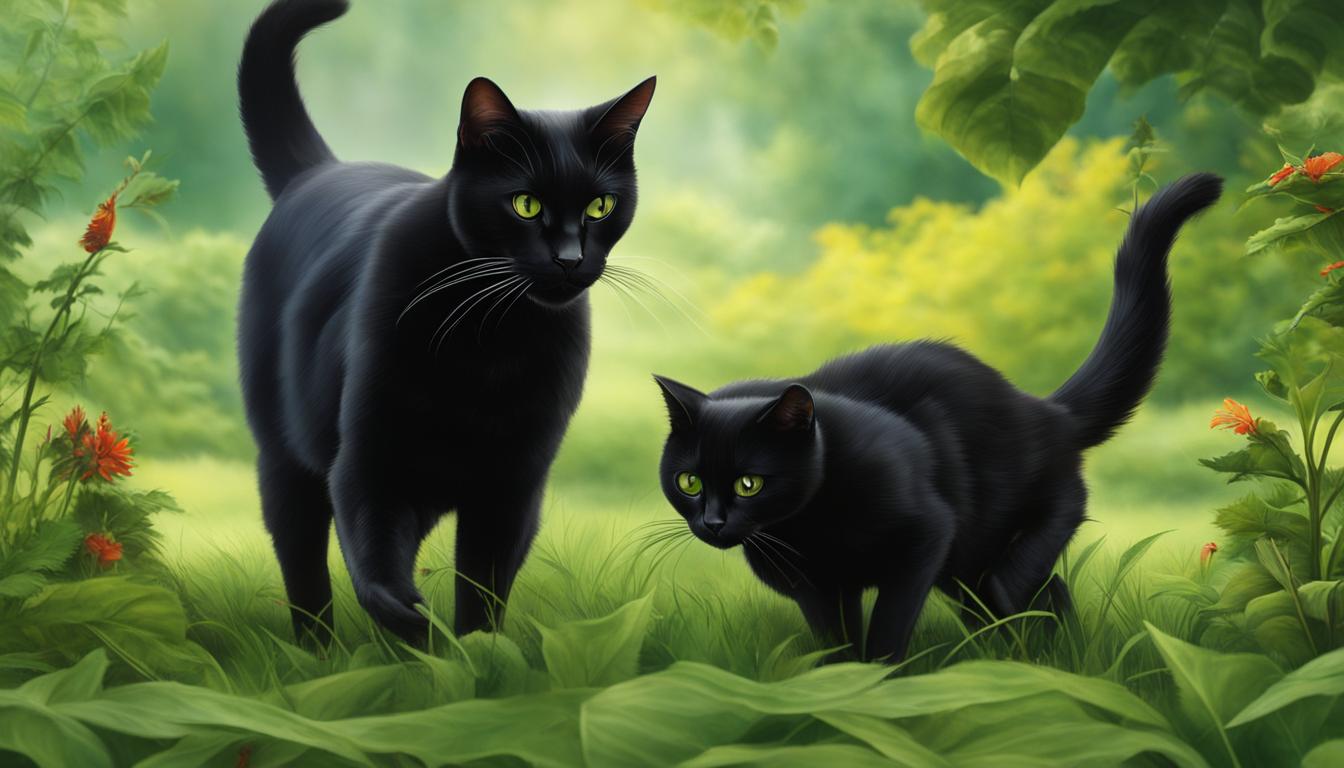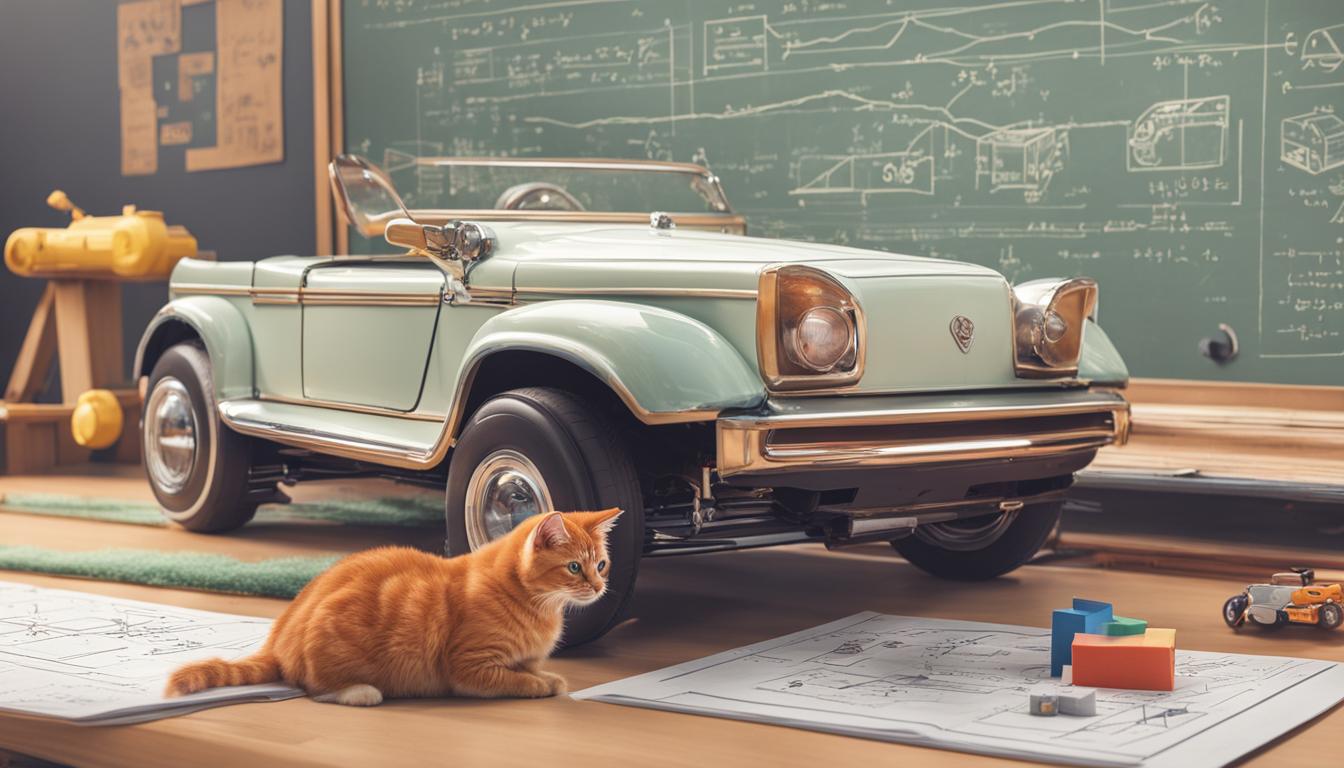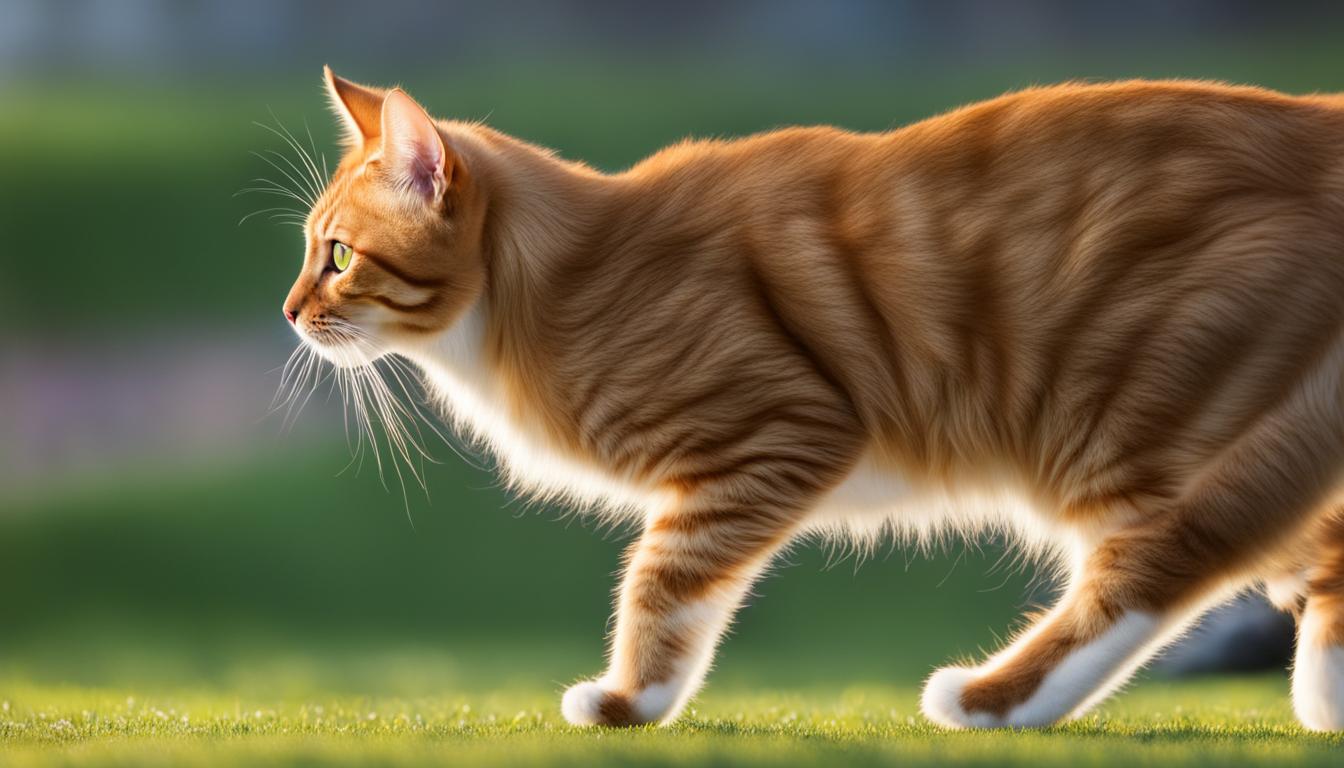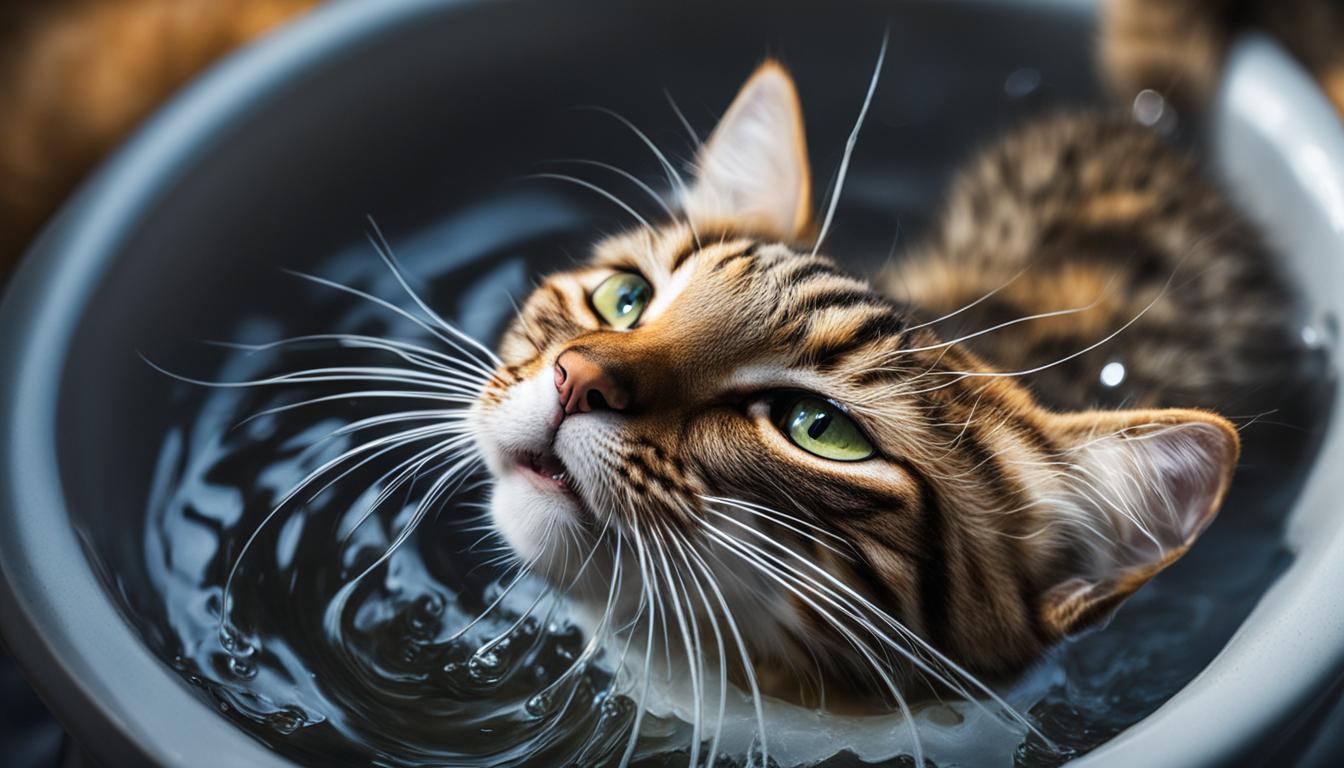Cats are natural-born hunters, and their hunting skills are a result of their evolutionary adaptation and use of physics. Ever wondered how cats manage to catch their prey with such precision and agility? It turns out that physics plays a crucial role in their hunting techniques.
From their keen sense of sight to their flexible spines, cats have a range of anatomical features that contribute to their hunting prowess. But it’s not just their physical attributes that make them successful hunters; cats also utilize physics to calculate the perfect trajectory for their pounce.
In this article, we’ll explore how cats use physics to their advantage when hunting, from predicting prey movement to the role of sight in their hunting strategies. By understanding these feline physics, we can gain a deeper appreciation for the remarkable skills and behaviors of our feline friends.
Key Takeaways:
- Cats use physics to effectively hunt their prey.
- Their anatomical features contribute to their hunting prowess.
- Predicting prey movement is a key element of a cat’s hunting technique.
- Cats have remarkable visual acuity, allowing them to spot prey from a distance.
- Cats’ hunting techniques can be compared to those of other animals.
The Anatomy of a Hunting Cat
Cats are incredible hunters, and their remarkable skills are rooted in their unique anatomy. From their keen sense of sight to their powerful limbs, cats are equipped with physiological adaptations that make them formidable predators in the animal kingdom.
One of the key features of a hunting cat is their acute sense of vision. Their eyes are specialized to detect even the slightest movement, allowing them to spot prey from a distance. Not only do they have excellent visual acuity during the day, but they also possess a reflective layer called the tapetum lucidum behind their retinas. This layer enhances their night vision, enabling them to hunt effectively in low-light conditions. With their exceptional vision, cats are able to track and stalk their prey with precision.
In addition to their remarkable eyesight, cats have sharp retractable claws that play a vital role in their hunting strategies. These claws are kept sheathed when not in use, allowing them to remain sharp and ready for action. When hunting, cats extend their claws to grip and capture their prey. Their retractable claws give them an advantage by ensuring that their claws are always sharp and at the perfect length for an effective catch.
Furthermore, a cat’s flexible spine and powerful hind limbs contribute to their agility and speed. Their spines are designed to be highly flexible, allowing them to twist and turn with ease while maintaining balance and stability. Combined with their strong hind limbs, cats can execute impressive jumps and pounces, propelling them towards their prey with incredible speed. These physiological adaptations make cats agile and swift hunters, increasing their chances of a successful hunt.
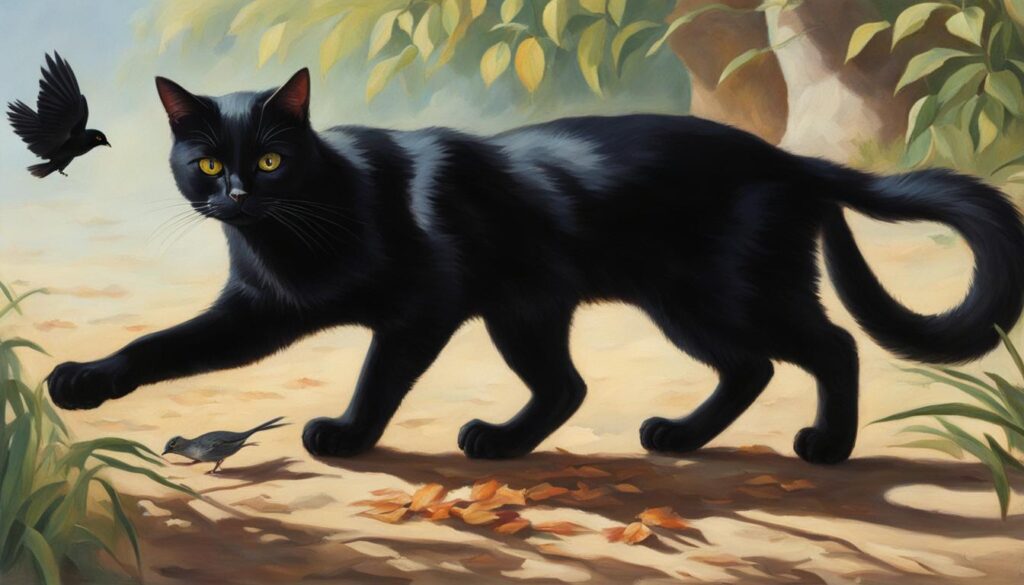
| Animal | Hunting Technique | Key Physics Principle |
|---|---|---|
| Cats | Anticipating prey behavior, calculating trajectory | Speed, trajectory, and prediction |
| Birds of Prey | Diving from great heights | Gravity and aerodynamics |
| Cheetahs | Chasing down prey | Acceleration and velocity |
Note: The table above compares the hunting strategies and underlying physics principles of different animals. While cats rely on prediction and trajectory, birds of prey use gravity and aerodynamics, and cheetahs depend on acceleration and velocity to catch their prey.
The Role of Sight in Cat Hunting
Cats are known for their exceptional visual acuity, which plays a crucial role in their hunting prowess. With their keen eyesight, they can detect even the slightest movement, allowing them to spot prey from a distance. This acute vision is attributed to their well-developed eyes, which are adapted to optimize their hunting abilities.
One remarkable feature of a cat’s eyes is the tapetum lucidum, a reflective layer behind their retinas. This structure enhances their night vision, making them adept at hunting in low-light conditions. The tapetum lucidum reflects light that enters the eyes, giving the photoreceptor cells a second chance to detect it. As a result, cats can see more clearly in the dark than humans, allowing them to stalk and ambush their prey effectively.
Cat visual acuity is further enhanced by their large pupils, which can dilate and contract rapidly. This flexibility enables cats to adjust their eyes to varying light intensities quickly. Additionally, their vertical-slit pupils provide them with a wide field of view, allowing them to spot potential prey from different angles.
The Importance of Night Vision in Hunting
“In the dead of night, a cat’s eyes become like glowing orbs, allowing them to navigate the darkness with ease.”
The combination of their excellent night vision and the ability to calculate optimal trajectories based on visual cues enables cats to execute precise and effective hunting strategies. By using physics to their advantage, cats can determine the perfect moment to pounce on their unsuspecting prey.
In conclusion, a cat’s sight is a fundamental component of their hunting skills. Their well-adapted eyes, acute vision, and night vision capabilities give them a significant advantage when stalking and catching their prey. By understanding the role of sight in cat hunting, we can gain a deeper appreciation for their remarkable abilities and the intricate ways in which physics contributes to their success.
The Art of Cat Hunting: A Comparative Look at Hunting Strategies in the Animal Kingdom
Cats are esteemed hunters, but they are not the only masters of the hunt in the animal kingdom. Various predators employ different techniques and utilize physics to ensure their hunting success. Let’s explore how different animals use their unique hunting strategies and understand the physics behind their predation.
Birds of Prey: Aerial Acrobats
While cats utilize speed, trajectory, and prediction on land, birds of prey dominate the skies with their unique hunting techniques. These majestic creatures, such as hawks and eagles, use their exceptional eyesight and wingspan to spot and swoop down on their prey. Their ability to calculate trajectory is essential for aerial maneuvering, allowing them to precisely target their quarry during a high-speed chase. The physics of flight and precise timing are crucial for their successful predation.
Cheetahs: The Speed Demons
When it comes to land pursuits, cheetahs are unrivaled in their speed and agility. These magnificent big cats can accelerate from 0 to 60 miles per hour in just a few seconds. Cheetahs utilize their long, slender bodies and powerful leg muscles to maintain balance and execute precise turns while in pursuit of prey. Their hunting strategy involves predicting the movements of their quarry and adjusting their trajectory accordingly to ensure an accurate and successful pounce.
While cats, birds of prey, and cheetahs exemplify the diverse hunting techniques within the animal kingdom, it is worth noting that each predator has evolved to excel in its respective habitat and prey selection. By studying these hunting strategies and the physics behind them, we gain a deeper appreciation for the intricacies of nature’s design and the remarkable adaptations that enable predators to survive and thrive in their environments.
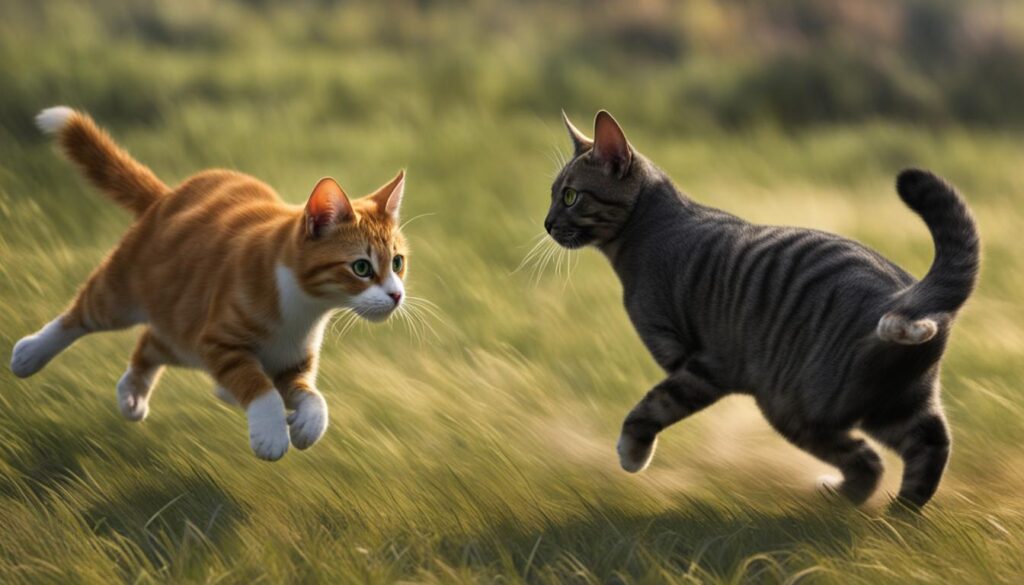
Table: A Comparison of Hunting Strategies
| Predator | Hunting Technique | Physics Involved |
|---|---|---|
| Cats | Predicting prey movement, utilizing speed and trajectory | Visual cues, speed calculation, trajectory prediction |
| Birds of Prey | Aerial pursuit, swooping down on prey | Flight physics, trajectory calculation, precise timing |
| Cheetahs | High-speed chase, accurate pounce | Speed, agility, trajectory adjustment |
Understanding how animals employ physics in their hunting strategies provides valuable insights into the diversity and complexity of nature’s tactics. By observing and appreciating the remarkable skills exhibited by various predators, we gain a deeper understanding of the laws that govern the animal kingdom.
Techniques to Improve Hunting in Cats
As a cat owner, you can help enhance your furry friend’s hunting skills by incorporating a few strategies into their daily routine. Encouraging natural hunting behaviors not only provides mental and physical stimulation but also strengthens the bond between you and your cat. Here are some techniques to improve hunting in cats:
1. Hunting Play for Cats
Engaging in interactive play sessions with your cat can simulate hunting scenarios and stimulate their natural instincts. Use toys that mimic the movements of prey, such as feathers or small, lightweight objects that can be easily tossed and chased. This type of play allows your cat to practice their speed and agility while honing their hunting skills.
2. Creating Hunting Opportunities
Provide opportunities for your cat to engage in independent hunting. Set up puzzle feeders or hiding spots where they can search for their food. This encourages them to use their senses and problem-solving abilities while satisfying their instinctual drive to hunt.
3. Outdoor Exploration
If it is safe and appropriate for your cat to go outdoors, supervised outdoor exploration can provide valuable hunting experiences. Allow your cat to explore natural environments where they can stalk, chase, and pounce on insects or small prey. Always ensure the safety of your cat by supervising their outdoor adventures.
Incorporating these techniques into your cat’s routine can help improve their hunting skills and provide them with the mental and physical stimulation they need. Remember to always prioritize your cat’s safety and well-being during play and outdoor exploration.
The Importance of Trajectory in Hunting
When it comes to hunting, trajectory plays a vital role in a cat’s success. Cats are instinctively skilled at calculating optimal trajectories to pounce on their prey, utilizing physics to their advantage. By understanding how cats calculate trajectories, we can gain insight into their sophisticated hunting strategies and appreciate the precision with which they execute their attacks.
The physics of a successful pounce involves a careful evaluation of factors such as speed, distance, and the movement of the target. Cats utilize their exceptional sense of sight to track their prey and predict its trajectory. With their keen vision, they can precisely calculate the angle and velocity at which they need to launch themselves to intercept their target. This precise calculation minimizes energy consumption and maximizes the chances of a successful catch.
To illustrate the importance of trajectory in cat hunting, consider a scenario where a cat is stalking a bird perched on a branch. The cat must accurately assess the bird’s movement and calculate the optimal trajectory to reach its target. By doing so, the cat can minimize the distance it needs to cover, conserve energy, and increase the likelihood of a successful capture.
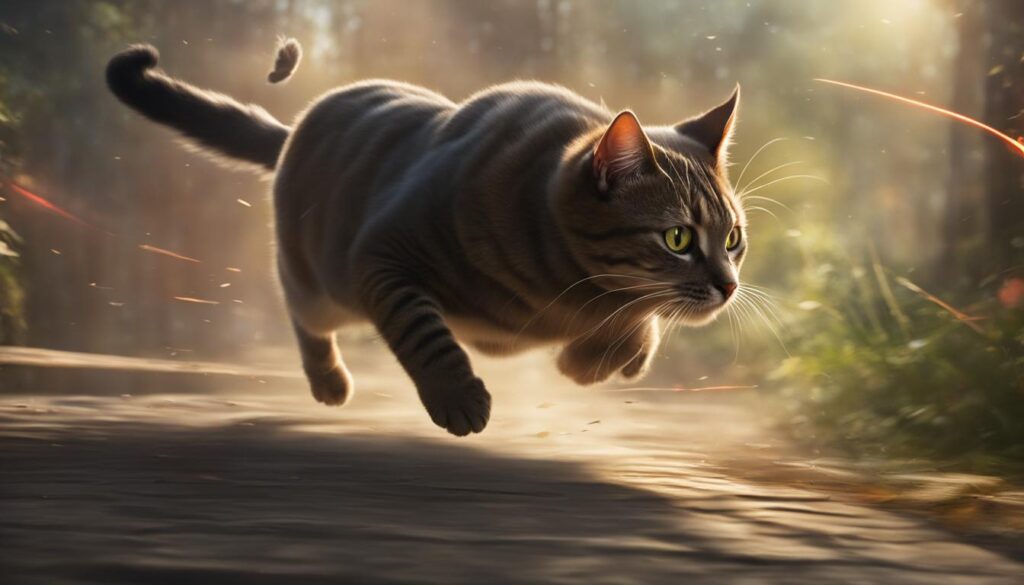
Key Takeaways:
- Cats are skilled at calculating optimal trajectories to pounce on their prey.
- They utilize their exceptional sense of sight to track and predict the movement of their target.
- Calculating trajectories allows cats to minimize energy consumption and increase the chances of a successful catch.
The ability to accurately calculate trajectory is a fascinating aspect of a cat’s hunting prowess. It showcases the incredible way in which cats utilize physics to their advantage, allowing them to effectively hunt their prey. By appreciating the importance of trajectory in cat hunting, we gain a deeper understanding of the remarkable skills and behaviors of these incredible predators.
Conclusion
As I conclude this exploration into the physics behind cat hunting, I am fascinated by the evolution of their techniques and the meticulous calculations they make. It is clear that cats have honed their hunting skills through centuries of adaptation and natural instinct. Their ability to choose the most energy-efficient hunting strategy is truly remarkable and showcases the complexities of their behaviors.
When observing a cat in pursuit of its prey, it becomes evident that they are not simply relying on instinct alone. Cats utilize physics to their advantage, predicting the movement of their target, calculating trajectories, and optimizing their energy consumption. Their hunting prowess is a testament to the remarkable combination of biology and physics.
Understanding the principles behind cat hunting can deepen our appreciation for the incredible skills our feline companions possess. By supporting and encouraging their natural hunting instincts, we provide mental and physical stimulation that is vital to their overall well-being. Through interactive play and environmental enrichment, we can create opportunities for cats to practice their hunting techniques and maintain a healthy balance in their lives.
So, as we marvel at the speed, precision, and agility of a cat’s hunt, let us recognize the evolutionary journey that has led to their exceptional hunting skills. From predicting prey movement to calculating optimal trajectories, cats have mastered the art of hunting by leveraging the laws of physics. It is a fascinating blend of science, instinct, and pure feline finesse.
FAQ
How do cats use physics to hunt?
Cats use physics in their hunting techniques by utilizing speed, trajectory, and prediction. They calculate the optimal trajectory to pounce on their prey, taking into account their speed, distance, and target movement.
What anatomical features contribute to a cat’s hunting prowess?
Cats’ keen sense of sight, sharp retractable claws, sensitive whiskers, flexible spines, and powerful hind limbs all contribute to their ability to hunt effectively.
How do cats predict the movement of their prey?
Cats rely on their exceptional vision and depth perception to anticipate the trajectory and speed of their target. They use visual cues and subtle body language to accurately predict the direction and timing of their pounce.
What role does sight play in a cat’s hunting abilities?
Cats have remarkable visual acuity and their eyes are adapted to detect even the slightest movement. They also have a reflective layer called the tapetum lucidum behind their retinas, which enhances their night vision and allows them to hunt effectively in low-light conditions.
How do cats’ hunting techniques compare to other animals?
Other predators in the animal kingdom, such as birds of prey and cheetahs, also utilize physics in their hunting techniques. They employ similar tactics of speed, trajectory, and prediction to catch their prey.
How can I improve my cat’s hunting skills?
Providing interactive toys that mimic prey movements can stimulate your cat’s hunting instincts and allow them to practice their speed and trajectory calculations. Engaging in hunting play with your cat can also strengthen the bond between you and provide them with an outlet for their natural behaviors.
Why is trajectory important in a cat’s hunting success?
Cats calculate the optimal trajectory to pounce on their prey, taking into account their speed, distance, and target movement. By understanding the physics of trajectories, cats are able to execute precise and effective hunting strategies.
What can I learn from cats’ hunting abilities?
Understanding the science behind cats’ hunting abilities allows us to appreciate the complexities of their behaviors and the remarkable skills they possess. It also provides insights into the evolutionary adaptations and behaviors of predators.

